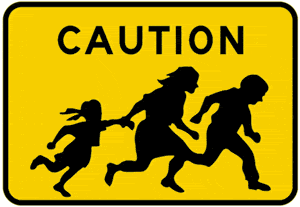With Only One Left, Iconic Yellow Road Sign Showing Running Immigrants Now Borders on the Extinct
Cindy Carcamo, Los Angeles Times, July 7, 2017

So many immigrants crossing illegally into the United States through California were killed by cars and trucks along the 5 Freeway that John Hood was given an assignment.
In the early 1990s, the Caltrans worker was tasked with creating a road sign to alert drivers to the possible danger.
Silhouetted against a yellow background and the word “CAUTION,” the sign featured a father, waist bent, head down, running hard. Behind him, a mother in a knee-length dress pulls on the slight wrist of a girl — her pigtails flying, her feet barely touching the ground.
Ten signs once dotted the shoulders of the 5 Freeway, just north of the Mexican border. They became iconic markers of the perils of the immigrant journey north. But they began to disappear — victims of crashes, storms, vandalism and the fame conferred on them by popular culture.
Today, one sign remains.
{snip}
A generation after they were installed, the last of the “running immigrants” signs stands on two wooden posts in a concrete median of northbound Interstate 5, just before a “Welcome to California” sign.
{snip}
In the 1980s, more than 100 people were killed as they tried to cross freeway lanes in the San Ysidro area and between San Clemente and Oceanside. Caltrans wanted to do something about the problem and asked Hood, a California Department of Transportation employee and Vietnam War veteran who grew up on a Navajo reservation in New Mexico, to come up with a sign that would alert drivers and could reduce the number of deaths.
He eventually settled on using the image of a family in an effort to tug at the heart in a way a typical road sign might not. A little girl with pigtails, he thought, would convey the idea of motion, of running.
{snip}
Caltrans first installed the signs in late 1990 and early 1991. After workers erected a median fence along the freeway’s trouble spots in 1994, officials decided not to replace any future signs that were lost. Around that time, federal officials launched Operation Gatekeeper, which fenced off the U.S.-Mexico border in San Diego — pushing illegal immigration east, toward Arizona and Texas. That helped reduce the number of freeway-crossing deaths, Caltrans officials said.
{snip}
Estela Dutra, a hairstylist at Selena Estetica Unisex on West San Ysidro Boulevard, said she always found the signs offensive. The image is akin to a cattle crossing, she said.
“It’s sort of humiliating, dehumanizing. It makes us look like animals … primitive people,” she said.
The 72-year-old, a naturalized U.S. citizen, illegally crossed the border 40 years ago. She entered with ease as a car passenger along the San Ysidro crossing, she said.
“I wasn’t asked for a passport or a visa,” she said. “Can you believe it? Those were different times.”
{snip}
So many immigrants and smugglers once illegally crossed the border here that Obdulia Morales tried to bar their passage along her Mexican restaurant with an iron gate.
Don Felix Café’s narrow-bricked alleyway, a little over a mile north of the southern U.S. border along West San Ysidro Boulevard, had become a perfect hiding spot for smugglers and the smuggled.
Morales, who dished up mole and menudo on a recent day, said it was a complicated time and business was booming. Back then, many shop owners knew who dabbled in human smuggling even as they served immigration enforcement agents who packed the border region.
“Border Patrol agents would come and eat here all the time,” she said, noting that smugglers did too.
As for the yellow caution sign, Morales said she almost had forgotten about it, even though the last one is not far from her diner.
{snip}















